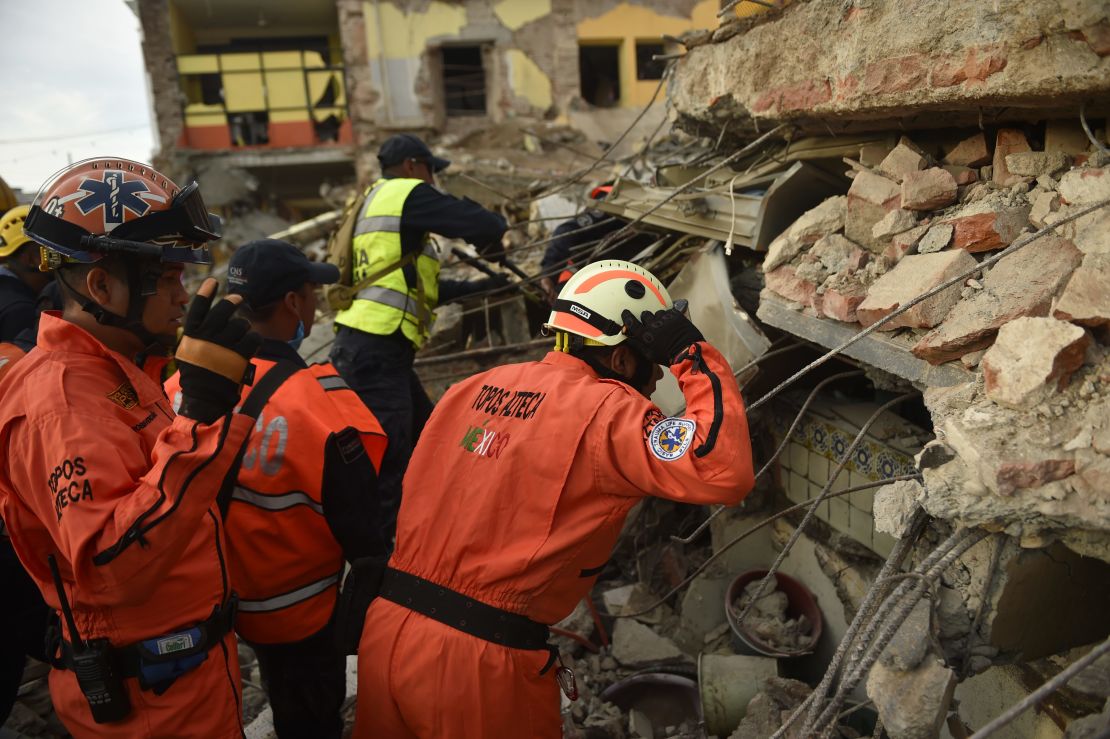Story highlights
Los Topos was formed after cataclysmic earthquake killed thousands 32 years ago
The idea was to bring a rapid civilian response to assist rescues
Members of “Los Topos,” or the moles, at times emerge from the ruins of collapsed buildings too traumatized to speak. The cries from those entombed in brick and concrete can be haunting.
“They’re waiting for you, at times in agonizing pain and you’re outside feeling the pressure to find them,” said Rafael Lopez, a member of the volunteer Mexican rescue group since 1985.
“They beg for help. They cry. They scream. You try to get them to calm down so they can give you a reference of where to find them. Are they near stairs, a hallway?”
The group was founded after the 1985 earthquake that killed an estimated 9,500 people in and around Mexico City.
Two hours after simulations and drills marked the 32nd anniversary of that disaster, central Mexico on Tuesday was hit with a magnitude-7.1 quake.
At least 280 people were killed and dozens of buildings turned into dust, Mexico City Mayor Miguel Angel Mancera told CNN affiliate Foro TV.
Members pay a psychological toll
Members of Los Topos, the Mexican navy and marines and other groups have been burrowing into the ruins after the country’s second major temblor in less than two weeks. Some members of Los Topos said they were on the street within an hour.
“You try to handle the victim with a lot of respect,” said Ivan Barientos Salas, 35, a member since 2006.
“You try to pull them out carefully. The psychological shock hits you later.”

Sometimes, bodies are gently placed on the ground. Some rescue group members say a brief prayer. Counselors are available before they return to the piles of debris.
The chance of reaching survivors diminish with each day.
There could be people trapped in at least 10 buildings in Mexico City, President Enrique Peña Nieto said Thursday. Search and rescue efforts were continuing.
‘You feel a lot of uncertainty but no fear’
In the neighborhood of Lindavista, north of the city center, Barrientos late Wednesday crawled into a narrow space created after the first two floors of a building collapsed.
“You feel a lot of uncertainty but no fear,” he said later. “There are paramedics there and your team has your back. You know you have a job to do. A family needs to know what happened to their loved one.”
He said he eventually reached the body of a man who appeared to have been crushed while trying to escape.
“There was furniture blocking his way in a corridor and he couldn’t get out when the building came down,” Barrientos said.
One of the most heart-wrenching scenes this week was at Colegio Enrique Rebsamen. The three-story school building pancaked into a pile of concrete rubble on the city’s south side. At least 25 bodies – 19 of them children – were pulled from the ruins.
For days, people were drawn to the search for a 12-year-old thought to be trapped in the elementary school. The search ended Thursday after officials said all students had been accounted for.
Still, there are indications that someone may still be alive in the rubble, Mexico’s naval sub-secretary Angel Enrique Sarmiento said Thursday.
“The children, most times, they have more chance to live than we the old people,” said Héctor Méndez, 70, who was one of the founders of Los Topos.
“The boys, they want to be alive and I know that. And that is why we are here working hard.”
Volunteers bring specialties to the task
Standing at dusk in a half-torn orange jumpsuit – the trademark uniform of Los Topos – Méndez said entering the rubble is like “crawling inside like a lizard in a hole.”
Méndez said he was proud of how his fellow countrymen had responded to the disaster.
“Society changed in 1985 after that earthquake,” he said. “It was a kind of cleaning. Because suffering cleans your spirit… So Mexican society now is a kind of catharsis – kind of a social catharsis, you see.”
Los Topos was formed after the catastrophic quake 32 years ago – when the government was criticized for its slow response.
“The government appeared days after and people took to the streets to help,” said Lopez, a civil protection specialist who joined Los Topos at the age of 19.
Lopez praised the government response this time but expressed concern over the number of building collapses.
“We’ve seen many newer buildings come down,” he said. “This indicates there may have been faulty construction with materials of poor quality and shortcuts in building regulations.”
Since 1985, members of Los Topos have helped in earthquakes and other natural disasters in Iran, Nepal, Haiti, Indonesia and even Florida.
Deadly earthquake rocks central Mexico
The rescue group – after a series of personal conflicts and power plays – has splintered into a handful of volunteer outfits throughout Mexico, according to members.
“The more hands we have out there, the better,” Barrientos said. “The more people we can save.”
Most members are trained in first aid, climbing and maneuvering collapsed buildings, the use of rescue dogs and firefighting. They are not paid and come from various backgrounds.
“We have a pianist, lawyers, doctors and paramedics, psychologists, vets, engineers and architects,” said Barrientos, who has a degree in quantum physics.
CNN’s Kara Fox and Ed Lavandera contributed to this report from Mexico City. Ray Sanchez reported and wrote in New York.













































